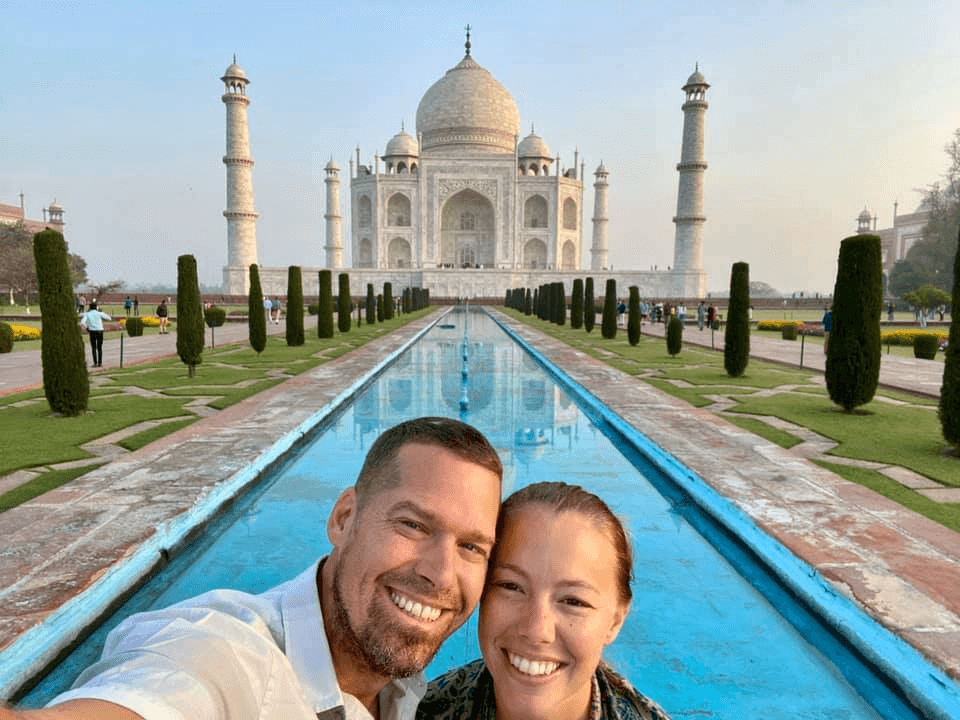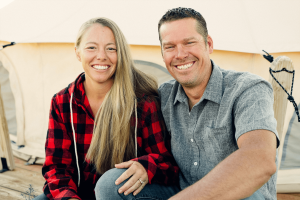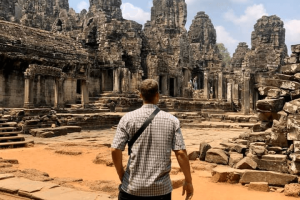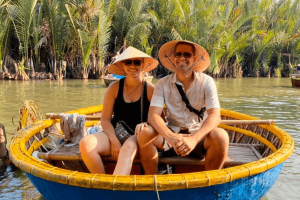India is a complicated country. It’s believed the people migrated into present day India 5500 years ago from the Ancient Indus Civilization; a civilization with one of the longest written histories on the planet. It’s physical diversity of landscapes excite, ranging from Himalayan mountains to jungles to farms and some the world’s largest cities. It’s overflowing with 1.3 billion people, making it the second most populous country in the world. Roughly eighty percent of the population practice Hinduism. The other twenty percent primarily practice Islam, Christianity and Sikhism; but these are not inclusive. Buddhism was founded and still practiced in India. There are many lesser known religions as well. I feel confident saying the religious history of India is amongst the richest on the planet, rivaling the overlaps in religion seen at Jerusalem.
We left ourselves one month to explore the country, but only 10 of those days were realized. Between the coronavirus restricting our travels and some unpleasant and harsh experiences, we significantly shortened our trip.
I want to start with a story I typically keep to myself…. One of my best friends growing up was Indian. He was born and raised in Toronto but came from a traditional Hindu family from India. Amjed was a bit older than me, but those years didn’t impede our friendship. One day, like the flip of a switch, he became depressed. The source of his sorrow: an arranged marriage to a woman he’d never met 8000 miles away. A few months later he was found hanging from his bedroom ceiling fan. He was one of my best friends, and as a teenager I thought it unfair being prematurely robbed of his companionship. From this, India has personally always been cloaked in mis-emotion. A hope of mine was this trip would mend that mis-emotion….
Our plane touched down in Delhi, the second largest city in the world, bursting at the seams with an estimated 29.3 million people. After clearing immigration and customs, we got in a taxi and started towards our bed and breakfast. Our driver asked why we got a place in the middle of the riots. We had heard about the Delhi riots a few weeks back, but thought they were over. The SIM cards we purchased at the airport wouldn’t become active for at least 4 more hours, so we had no phones, no means of email or correspondence and no internet. When we explained our phone situation to the driver, he offered to call our bed and breakfast host for us. After a short conversation in Hindi, our driver passed the phone to me and our host confirmed his house was not safe with the riots and police mandated road closures. He tells us he’s going to have the driver drop us off in a safe area nearby and he’ll come get us, when he can safely leave his house. So we get dropped off in the middle of the night, in an area with precious little around, at a tourist info center. The riot talk and drive to the tourist center was a setup for a scam. Turns out the location was nowhere near our B&B. The tourist center pitched an emergency train ride into a safe zone at an outrageous price. The schemers knew our phones wouldn’t work for a while. In that time, they worked at building as much fear and panic as they could. They proceeded to make a barrage of fake phone calls. They had fake customers verifying how helpful and great the tourist center was. They had fake websites on the ready to address our doubts. They pushed fake news with an impressive supporting team. Fortunately, we had more suspicions and questions than answers. We insisted on a walk to discuss things, in private; something they attempted to suppress, but grudgingly had to concede. That’s when we flagged down a Delhi police officer and verified it was the most comprehensive and organized scam we’d ever witnessed in person. And we came to discover later, a very successful one. If only they could funnel that energy into an honest enterprise, they’d probably have an extraordinarily successful business.
Welcome to India.
After the police verified the tourist center was trying to rob us, we found a restaurant that let us use their phone and wifi. We called our real bed and breakfast host and ordered an Uber. We certainly wouldn’t take another cab while in India! Upon arriving at the B&B, we were greeted warmly and informed that our timing was impeccable. Two hours after our plane landed, the Indian Government announced all future tourist VISA’s are to be canceled due to the Coronavirus; active VISA’s are exempt and were still good for travel; no re-entries permitted. With that we bid farewell to our goal of visiting Nepal and Sri Lanka. We will have to just make the most of India.
It’s time to discover this exotic and strange land. When Keshia and I travel, we walk everywhere. It allows us to see and experience the real culture and nature of a place. We often discover hidden gems, learn interesting things and appreciate the exercise. Unfortunately, walking here revealed the uglier side of India. We were intimately introduced to poverty and filth; scams and cons; massively marked up prices on goods and services; harassment and objectification.
As a tourist in poorer countries, you are always a tourist target. Throughout south east Asia we made easy targets, but the people there were generally pleasant and accepting of communication. In India, the people were too often angry and aggressive, never willing to accept no for an answer. When we’d finally shake one sales pitch, we were usually immediately greeted by another. Vehicles would stop in the middle of the road, holding up traffic to pitch their service. It was relentless and tiring; there was never a break, ever.
We’d read and heard about India’s poor sanitation. But that did little to prepare us for the reality of it. Locals toss garbage into the streets without thought or regard. Trash flows so thick upon creeks and streams it restricts the flow of water. In rivers the trash clusters and floats like rafts; it accumulates on the banks and suffocates the ecosystem. Virtually every gully and depression in the ground is filled with waste, like an unintentional or organic rubbish bin. At the train station, workers sweep the platforms of debris directly onto the tracks, as if that would make it magically disappear. Men urinate when and where they please. Open sewers abound. It was disturbing to see the environment being taxed and abused, but not surprising considering the poverty and overpopulation problems India faces.
The horn use in India is unlike anything you’ve ever heard. We’re not talking about regal horns of Gondor here. We’re not talking about New York City Streets in the 1990’s. These are the incessant horns of India, overlapping, constant and piercing. Drivers in India don’t use their horns in alarm or emergency situations. Instead they use them to communicate every move and thought they have on the road. Horns are used to notify passing intent; horns are used to signal location; horns are used to warn animals and pedestrians; horns are used when there’s no reason to use them. There were literally times Keshia and I witnessed lone drivers on the road, leaning on their horns when no one was around. I remember one evening stopping in my tracks trying understanding why. Perhaps that driver was using his horn out of routine? Perhaps telling other drivers it’s not safe to pull out of their driveways? It’s a phenomenon you must witness in person to truly appreciate and understand. There was never a moment of audible peace and tranquility in any of the big cities we visited. Once out of the big cities, free of overcrowding and congestion, the horns became less invasive, but they were always there, even in the farming communities and villages. “Beep, beep, beep… beep, beep, beep… beep, beep, beeeep!”
You can’t visit India and not mention the unique relationship it has with animals. Some are owned, most are wild, and all wander the earthen alleys, busy roads and concrete highways. In the cities, cows literally chew garbage, masticating plastic in a failed search for ever-elusive cellulose and nutrients; dogs and monkeys find food in piles of trash; pigs eat unidentifiable fecal waste and lord knows what the donkeys and goats eat. They are often a nuisance but seeing as the cows and monkeys are sacred and the other animals are protected, there is no placed for them to go. So, they cause traffic jams and add a unique layer and texture to a land of many peculiarities. We quite enjoyed their company, despite the struggle watching hundreds and thousands of them toil through horrendous living conditions.
The worst part of our trip was how Keshia felt constantly assaulted by Indian men. They’d relentlessly and awkwardly stare her down as if she were not human, but meat. It was as invasive and uncomfortable for her as it was infuriating and frustrating for me. I was incapable of quelling the stares or comforting my wife. One day we were walking through some back alleys lined with homes. Our spirits were high that afternoon. Off the tourist track we were finding the people friendlier and tourist harassment negligible. Later we both confessed, “that was the India we were hoping to discover more of.” But that high was quickly extinguished by an adolescent teenager running up behind Keshia and sexually assault her. Keshia punched him and he ran off before I even knew what had happened. It was a heart wrenching moment, watching the tears well up in her eyes. In that moment, in an unspoken agreement, we both knew the trip to India was over. In fact, we would have booked a flight out of India the next day had we not already made plans to visit a friend in Punjab.
It wasn’t just Keshia either. Nearly every tourist woman we talked to in India had a story of being mistreated or violated. An Irish woman staying at our B&B told us a man crawled under her blanket while she was in her sleeping berth on the train. Another woman told us of a man who attempted to enter her hotel room. Upon coming home, another friend told us of her mission group all being sexually assaulted back in 2004. Apparently, this has been an ongoing fault in the fabric of Indian culture for a long time.
Another behavioral anomaly that surprised us was the emotional tone of the general populace. The overwhelming majority of the people we encountered were not polite, courteous, friendly or even pleasant to be around. Human interactions were bereft of basic communication; words like “hello” or “thank you” or “goodbye” were rare and fleeting. When we did encounter communication, it was usually directed at us, but reciprocating efforts were disregarded or unwanted. We assume this has something to do with the cast system. Certain people are lower is status and are not worthy of communication? Perhaps it could also be a symptom of overpopulation and the distrust of crime that tends to accompany it? Regardless of reason, it’s there, an observable social distain for fellow man.
Keeping our promise and plans to visit Soni in Punjab, we flew to the northwestern part of the country. Here we discovered a wholly different India, a place that left us with a higher degree of emotional peace and intrigue than anywhere else we’d been. This province is where Sikhism was founded and remains predominantly Sikh to this day. We found the Indians here to be more community oriented, friendly, honest and hardworking than those we encountered in the other parts of India. In fact, immediately upon landed at Amritsar airport, Soni and her Sikh family greeted us and adopted us as family, a welcome embrace following months of travel.
After being picked up at Amritsar International Airport, we received an intimate and spiritual tour of the holiest of holy Sikh places, their ‘Mecca,’ The Golden Temple. Community Service is a pillar of Sikh culture. Most Sikhs volunteer at temples providing langar (vegetarian food) in communal kitchens called ‘gurdwaras.’ The Golden Temple does this on a grand scale, feeding 100,000 people per day. It was an honor sharing that meal with Soni and her family. It was a simple meal, hastily eaten with crossed legs directly upon the floor. Hundreds ate at a time and the rooms were turned over quickly, but the speed didn’t erase the feel of community and ceremony. And as we’d come to expect of India, the food was delicious! In addition to participating in langar, we washed our feet and arms in the holy waters surrounding the main temple and were guided through the gurdwaras, prayer chambers and pathways we would never have discovered without our devote and accommodating hosts.
After our tour of the Golden Temple, we moved to a small farming village four hours from Amritsar, called Manupur. The people here were quick to smile and generous with their laughs, traits we’d sorely missed after departing South East Asia. And the sense of community was inclusive and harmonious. The villagers cared for one another and would help each other without desire of reward. For example, Soni’s father was paying to fix a villager’s roof and rebuild his home because he could afford to. This man wasn’t family, he just wanted to help. And Soni is paying her younger cousin’s school tuition because she can afford to. Most of the time we couldn’t understand the villagers, but that didn’t impede our relationship and bond with them. While words often eluded both sides, the meaning behind hand gestures and laughs were usually duplicated clearly. One of the family friends who drove us around understood a few words of English. He would usually respond laughingly to everything we said with, “No problem!” It had become a running joke. As he drove us to the airport on our final day in India, I pointed to the red light he was about to barrel through, and with a hearty laugh, he bellowed, “No problem!” All three of us nearly died in laughter, as he ran the red! Since we began this adventure, random strangers would approach us and ask for pictures. I’ve heard there is even an Indian Facebook page dedicated to pictures with foreigners. The people we met in Manupur did take a few photos, but for memory not posting online. They were genuinely happy to meet us and hang out with us. Rumor has it we were the first white people to ever stay in Manupur. The people here treated us as their own. It was a refreshing change of pace from the India we first arrived to. It was honestly the most human we’d been treated since leaving home soil. We owe a debt of gratitude to Soni and her family for concluding our final leg of our journey on such a high note.
Before our finale in Punjab, most of our time was spent in and around Delhi and Agra. We’ve been told these two cities are the dirtiest and most aggressively unpleasant tourist destinations in India. But they also serve as one of the main gateways to the country and the Taj Mahal. Our original itinerary had us meandering south after Punjab…. Jaipur, Mumbai, Goa, Kerala…. And then north again towards Varanasi and Nepal. These are rumored to be more tourist friendly destinations than Delhi and Agra. Between sexual assault and the ever-expanding travel restrictions imposed from the coronavirus panic, our opportunity to verify these rumors were evicted with us.
As much as we enjoyed staying with Soni and her family, it was time to go. The Coronavirus panic was seizing borders and restricting travel by the minute. Timing has been on our side over these past months, and our decision to leave when we did was no exception. The day after we flew home, India closed its borders to incoming and outgoing flights. One more day and we would have been stranded.
The coronavirus was ever lurking over us, casting us in its shadows as we traveled. Eventually, our travels succumbed to it. Instead of hiking in Nepal or wandering the alleyways in Istanbul, we’re self-quarantined in the US. Instead of driving the coast of Labrador and exploring the mountains of Alaska, we’re now practicing social distancing, as we try to figure out what to do with our lives.
And just like that, our grand tour of the world is prematurely over. We carry few physical souvenirs, but our hearts are filled with memories and experiences that will live with us forever. This trip has fundamentally changed us. It has made us reevaluate our needs and reshaped our wants. We have a new perspective that has altered the way we view the world. We have journeyed through landscapes that have redefined awe. We have explored the ruins of ancient civilizations that inspire learning and enlightenment. We have had the honor of meeting some of the most distinguished and diverse people the world over. We’ve basked in the radiance of love, wonder and beauty. We purchased a ticket around the world and taking the ride has paid dividends beyond our wildest dreams. And if your reading this, our last and final international blog entry, thanks for traveling and being with us on our journey.







